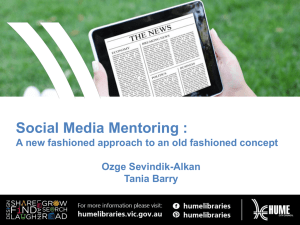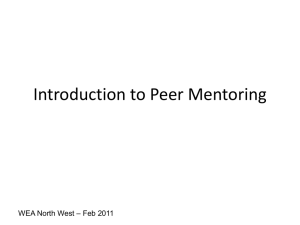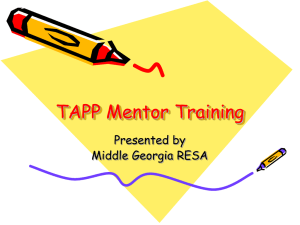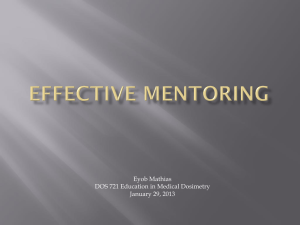QSA/FinS Mentoring Training Materials (Provided by
advertisement
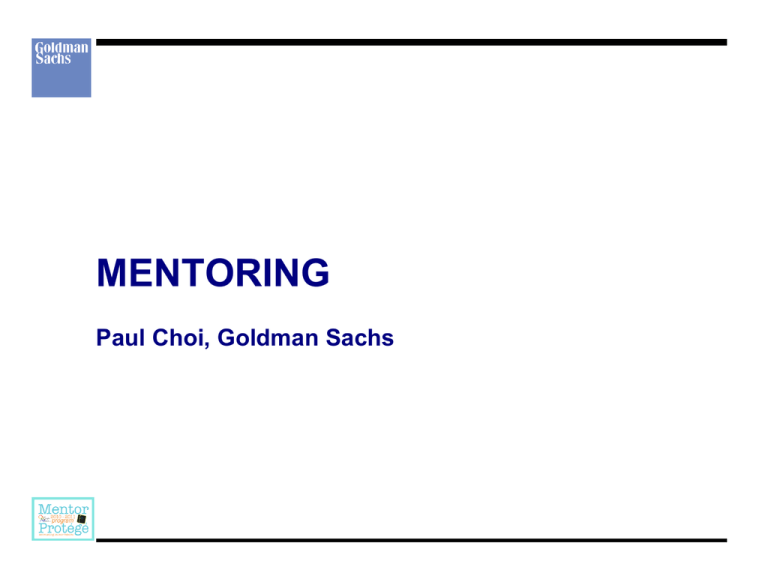
MENTORING Paul Choi, Goldman Sachs OUR ROUTE MAP FOR TODAY Why Mentoring? What is Mentoring? The Mentoring Relationship Tools, Techniques, Best Practices Why Mentoring? WHAT CEO’s SAY CONTRIBUTED TO THEIR SUCCESS WORKPLACE EXPERIENCES: Formal management training Being given challenging assignments Broadening of experience via tasks 20% 50% 65% Having a mentor 80% WAR FOR TALENT Development seen as most beneficial by high performers: stretching assignments strategic insight exposure to top people a mentor McKinsey War for Talent 1997 What is Mentoring? MENTORING Provide protégés with the foundational skills necessary for their future success within their given career path / choice. Develop a community of prospective future professionals and leaders who give the protégé an edge on his or her professional career, as well as inspire, motivate and enlighten the next generation of leaders. “Mentors are those special people in our lives who, through their deeds and work, help us and inspire us towards fulfilling our potential” David Clutterbuck & David Megginson 1997 MENTORING IS… A partnership Confidential Positive development activity Understanding and trust Two way learning relationship WHAT’S IN IT FOR THE MENTOR? Own development, rethink one’s own skills and techniques Opportunity to be challenged Exchange of good practice Improvement of one to one skills Insight into relationship skills with other contacts Satisfaction at seeing someone else grow Reverse Mentoring WHAT CAN A MENTOR OFFER? A broader, more strategic view of the business Help in developing networks An impartial view of the protégés capabilities and help with development opportunities Informal discussion of career paths and options Talking through day to day issues The Mentoring Relationship MENTOR / PROTÉGÉ FROM HELL Protégés (form two groups) discuss for 5 minutes what a mentor from hell looks like Mentors (form two groups) discuss for 5 minutes what a protégé from hell looks like Intensity of Learning PHASES OF THE MENTORING RELATIONSHIP Building Setting Rapport Direction Making Progress Time Moving On BUILDING RAPPORT Creating the right environment Getting comfortable with learning / helping style Developing a shared sense of purpose Sharing values Agreeing the “contract” SETTING DIRECTION Jointly agreeing on specific goals and milestones Exploring commitment Beginning the dialogue of how to achieve goals PROGRESS MAKING Each party adapting style to changing needs Providing challenge and support Being available Stretching ones’ own intellect and ability Reflective dialogue and insight WINDING DOWN Recognising when it is time to encourage independence Discussing openly when and how to move on Celebrating success Tools, Techniques, Best Practices For Protégés PROTÉGÉ DRIVEN LEARNING Traditional Teaching Direction of learning Information and knowledge flows from teacher to learner – agenda set by teacher Mentoring Direction of learning Protégé drives the relationship and the agenda, and uses mentor to refine ideas and strategies Teacher provides feedback based on extrinsic observations – aims to build skills One-way from teacher to learner Teacher identifies and provides opportunities to learn Two-way pro-actively driven by protégé Protégé reflects, makes intrinsic observations and discusses with mentor – mentor aims to help make significant transitions Protégé seizes opportunities to experiment PROACTIVE PLANNING: VISION Things I Really Enjoy Doing What Brings Me Happiness / Joy The Two Best Moments of My Past Week Three Things I’d Do If I Won the Lottery Issues or Causes I Care Deeply About My Most Important Values Things I Can Do at the Good-to-Excellent Level What I’d Like to Stop Doing or Do as Little as Possible PROACTIVE PLANNING: CAREER DEVELOPMENT 1 Who am I? What am I doing now? What have I done? My motivation, my credentials? 2 Where do I want to get to? My vision What’s happening out there? My needs, my priorities? The options? 3 How realistic is this? What can I offer? What could stop me? Where are the gaps? 4 How do I get there? Intelligence gathering? Building my skills, knowledge, competencies? Key experiences? Networking? Profile and reputation? PREPARING FOR REGULAR MENTORING MEETINGS 1 Issues remaining from previous meeting 2 Issues on which I need guidance or a different perspective (prioritize in terms of importance) 3 Examples and documents to help illustrate what I mean 4 Ideas and options Tools, Techniques, Best Practices For Mentors GUIDED DISCOVERY Help protégés find their own solutions rather than dictating the answers Use questioning techniques to guide them in discovering their solutions The GROW model of questioning: Clarify the goal Raise awareness Explore Options Way Forward GROW: Review an Experience G Clarify the goal What were you trying to achieve? R Raise awareness What happened? What did you do / what did you say? O Explore options What, if anything, would you do differently next time? What did you achieve? What would you continue to do, or build on for next time? What problems did you encounter? What have you learnt from the experience? What worked well? What aspects had you not anticipated? W Way forward What are the next steps? Who can you enlist to support you? What is the timing? GROW: Explore an issue G Clarify the goal What are you trying to achieve? R Raise awareness What is happening now? Where do you want to be? What have you done about it? O Explore options What options have you thought of? What are the pros / cons of those options? Way forward What are the next steps? Who can you enlist to support you? What is the timing? What is working well? Where could you get additional information? How will that add value? What are the obstacles? Who are the key players? Are shorter term goals needed to reach the end goal? W THE MENTORING MEETING Establish a relaxed, yet learning like atmosphere Gain consensus on the purpose of the meeting G Explore the issues from the protégé’s perspective Summarize and agree on next steps Clarify the goal R O W Raise awareness Explore options Way forward AFTER THE MEETING Questions to check effectiveness of meeting : % of talking - 80% protégé ? who asked the questions? who found the solutions? who did the creative thinking? Write up notes summarising the meeting: learning achieved actions issues for next session how well did the meeting run? Tools, Techniques, Best Practices For Both Parties CHECKLIST FOR FIRST MEETING 1 Introduction and Background Share information on: Career history Current role and working relationships – boss, direct reports, peers, clients, others Interests outside of work 2 Protégé’s Career and Development Goals Where do you want to get to in your career? Where do you want to be in 3 years? What are your strengths or enablers that might help you in getting there? What are your weaknesses or obstacles that might hinder your progress? What are the main areas you would like to focus on: –For –In 3 4 your current role? preparation for future jobs? Mentor’s Helping Style How would you like to help? (e.g. by providing feedback, sharing Expectations from the relationship What will make this a satisfying relationship for both of us? What do we expect to learn from each other? How often will we meet? Who will take responsibility for arranging the experiences, being a sounding board, brainstorming, guiding, coaching) Prior examples of having helped someone develop meetings? Do we want to set any ground rules? (e.g. confidentiality, honest feedback, things to avoid, what we will tell others, etc.) How will we check if this is the ‘right’ relationship for both parties? How will we resolve concerns on either side? Do we believe our expectations match? 5 Next Steps What issues do we want to begin working with now? What do we do between now and the next meeting? When will we meet next? What will we cover in the next meeting? KEY MESSAGES TO REMEMBER Effective mentors talk 20% of the time or less Mentors should help protégés find their solutions Protégés should drive the relationship Meet regularly - at least once every 4-6 weeks “No fault divorce” – Review relationship after two meetings. If this is not the right relationship, mentor should help protégé think through what he or she needs in a mentor Maintain confidentiality, but do not guarantee it – Illegal / Unethical issues might need to be reported Have clear objectives for each meeting and actions plans for between them Meetings should ideally last 60-90 minutes. Put an extra half hour in calendar to allow for overruns Deal with both short term problems and long term development Mentoring helps both parties QSA Events Networking Events Oct Ğ Dec 2010 5 Oct - Of ficial Launch of QSA (P) 2 Nov - Inclusion Recruitment Conf erence (M/P) - Movie Night- Prayers f or Bobby - End of term party 19 Nov Nov / Dec 19 Oct - Mentor Protg Program - Networking Gathering 16 Nov - Leo Burnett and FinS - The P!NK Dollar Survey 21 Dec - Holiday Celebration Jan Ğ Mar 2010 Jan Feb Mar - Q- Talk - Movie Night (TBC) - Q- Talk - Movie Night - Social Event - Semester Ends 18 Jan 15 Feb 15 Mar - Business Showcase (TBC) - Networking Gathering - Business Showcase (TBC) - Networking Gathering - Business Showcase (TBC) - Networking Gathering Program Components 10 Program Requirements for the Mentor / Protégé 2010 Program # Date OR Due Date 1. 2. 3. 4. 5 6 7 Event Steps Mentor P rot g YES YES - Training workshop prement orship program - Hosted by Goldman Sachs - To help students make the most use of the program - Tips and advice on doÕs and donÕts - T raining by Big-Name Corporate Management Optional YES 2 Nov 2010 - Inclusion Recruitment Conference Oct-Dec - Career Development YES YES P lanning for P rotégé 1st Semester - Work based trainingYES YES one day program OR Nov - Internship at Ment or's Company / Corporation - Tour Ment or's business office 16 Nov - Social Networking YES YES Eve - FinS Monthly / DROP 20 Dec - P rovide feedback on the YES YES effectiveness of the mentoring partnership via anonymous survey(s) - P rovided by QSA / FinS T BC Jan - T our Protégé’sCampus YES YES - T BC-on Campus Activit y / Exhibit ion 27 Oct How Engaged T eam / Group ALL Mentors Pro tégés Face to Face E-Mentoring Face to Face Face to Face ALL Mentors Pro tégés E-mail to QSA / FinS T eam / Group ALL Mentors Pro tégés Program Components 10 Program Requirements for the Mentor / Protégé 2011 Program # Date OR Due Date 8 Jan-Feb 2011 9 Feb 10 15 Mar 15 Mar Event Steps - T BC / Attendexperience sharing organizedby QSA - UP DATE / Career DevelopmentP lanning for P rotégé - Evaluation Form - Mentors andProtégés - Graduation - Celebrate end of P rogram - Certificates/ Gifts - FinS Event Mentor YES P rot g YES How E ngaged T eam / Group ALL Mentors Protégés YES YES E-Mentoring YES YES E-Mentoring YES YES E-Mentoringor Group Networking Principles 1- Turn Off the Computer and Get Out and Meet People. 2- Be Proactive Not Reactive. 3- Be Specific About What You Want to Pursue, Being Vague Will Get You Nowhere. 4- Make a First Great and Lasting Impression. 5- Being Shy is not Going to Get You Anywhere. 6- Tap Into the Strength of the Weak Concept- Those who know you the least will give you the strongest recommendations. The people who know you the best are going to be the least helpful. 7- Stay Positive & Motivated There is great opportunity in front of you and you should take advantage.


